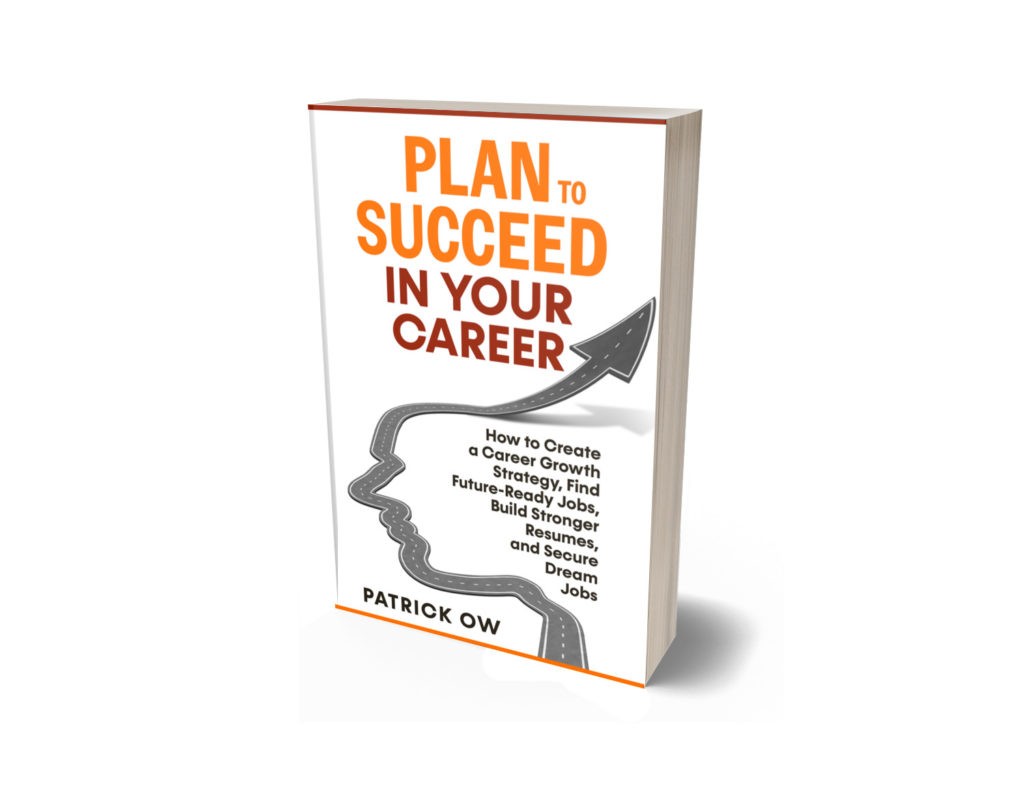Plan to Succeed in Your Career: How to Create a Career Growth Strategy, Find Future-Ready Jobs, Build Stronger Resumes, and Secure Dream Jobs

This is an incredibly practical book for individuals wanting to succeed in their careers through planning and commitment to future success.
Patrick Ow (of PracticalRiskTraining.com) notes that many job seekers will wait until they must write a resume and cover letter to identify the achievements required to impress the recruiter or hiring manager. By this time, it is too late. Many years of hard work are lost or are unaccounted for.
Achievements written in resumes do take time to set up and complete. There needs to be intentionality and planning to proactively reverse engineer the outcome or opportunities you want to enjoy being successful in your career, or even work towards securing your dream job.
In life planning, the commonly used tombstone test consists of two questions:
1. What do you want your tombstone to say?
2. Are the actions you are taking today in line with the legacy you want to leave?
Similarly, from a career planning perspective, the resume test consists of two questions:
1. What do you want your future resume to say?
2. Are the actions you are taking today in line with the career achievements you want to be proud of?
In this practical how-to book, you will learn how to:
1. Create and implement a career growth strategy.
2. Build your professional presence.
3. Act and plan now to succeed in your career in the longer term.
4. Find what your occupational interest is.
5. Align your career aspirations to your personality.
6. Identify the work values that will enable you to be successful at work.
7. Find in-demand, future-ready jobs in future-proof industries.
8. Identify and close gaps in your knowledge, abilities, and skills to succeed in your dream job.
9. Intentionally building up your achievements over time to impress future recruiters and hiring managers, build stronger resumes, and get hired in your dream job.
10. Proactively reach out to dream job employers to secure your next dream job.
11. Future proof your job and improve your job security.
Practical steps to develop and implement your career growth strategy:
• Know who you are and your purpose in life.
• Establish a clear vision of what you want to achieve with your life by knowing your WHY.
• Set goals that are personal and meaningful to you including your career and life goals.
• Develop strategies and plans for achieving your goals and being successful.
• Understand your limiting beliefs and things that may stop you from achieving your goals.
• Staying motivated and committed by rigorously executing your strategies and plans without getting distracted by everyday challenges.
• List down your non-negotiable criteria when evaluating which dream job employer to work for.
• Update and optimize your call, resume, letter, proposal, follow-up, and LinkedIn to fit any advertised job.
• Prepare job interview answers to behavioral questions.
• Identify the in-demand industry you want to play in.
• Identify the job- and future-ready skills, experience, competencies, and certifications required in that industry and dream job to achieve your career goals.
• Identify the equivalent job titles that will utilize your skills, experience, competencies, and certifications.
• Target and list down your dream job employers that require similar job titles and your skills, experience, competencies, and certifications.
• Network your way into these dream job organizations.
• Conduct informational interviews with people in your bucket-list employers to validate your assumptions, criteria, and obtain ‘insider’ information.
• Get around the hidden job market and the applicant tracking system.
• Curating and sharing relevant information on social media platforms, etc.
• Serving people in your networks by giving them value without asking for a job.
• Continuously reading, upskilling, and updating your knowledge.
• Constantly investing in yourself.
• Enhancing your brand and professional presence.
This book aims to prepare individuals to be job-ready for their next dream job and future-proofed in their job security.
Contents
Preface
Create and implement a career growth strategy
Building your professional presence
Deciding to change for the better
Find what your interest are
Align your career to your personality
Identify your work values
Find in-demand, future-ready jobs in future-proof industries
Identify and close gaps in your knowledge, abilities, and skills
Intentionally building up your achievements
Proactively reach out to dream job employers
Future-proof your job and improve your job security
Bonus chapters
Strategies to get hired fast
Prepare a compelling resume
Be ready for your next job interview
Why read this book?
Many resumes have been written to come across as a ‘doer,’ as opposed to an ‘achiever.’ It is easy to write sentences that are task-based and not results-based. This means that they tell you what you did, instead of what you achieved.
Employers want to know about the tangible contributions you have made (i.e., what value did you create for your employers) and specifically how you’ve made a positive difference at work (i.e., increased revenues or reduced cost). More importantly, they want to know how you are going to make a significant future difference in their organization if you are hired.
The contemporary paradigm requires employees to quantify and justify their successes and achievements, especially in their resumes, cover letters, LinkedIn profiles, and job interviews.
When you can quantify your achievements and results, you can effectively demonstrate value creation to your employer – current and future. If you are receiving $100,000 per year in salary, then you should be creating value more than $140,000 per year for your employer! (Salary cost plus benefits, taxes, etc.)
Therefore, don’t just say, “I wrote articles for a local publisher.” Instead, quantify your achievements by saying, “I wrote 10 articles per week for ABC publisher. They have 100,000 readers located in five districts. Their average reader satisfaction score is 4.6 over 5.”
Focus on how many, how often, and how much. This should be your standard approach regardless of whether you are looking for a job, or just talking with a colleague.
Numbers easily quantify success. They quickly give an employer the motivation to hire you! No more BS or fluff.
Unfortunately, the problem for many job seekers is that they wait until a resume and cover letter are needed that they then scramble to identify the achievements needed to impress the recruiter or hiring manager. By this time, it is too late. Many years of hard work are lost or are unaccounted for.
Achievements written in resumes do take time to set up and complete. There needs to be intentionality on your part to proactively reverse engineer the outcome or opportunities you want to enjoy in a successful career, or even work towards securing your dream jobs over time.
You need commitment, effort, time, and a plan to be successful in your career, or anything in life.
Begin with the end in mind (Habit 2) is one of The 7 Habits of Highly Effective People that Stephen Covey’s famous bestseller defines. At its most basic form, it means to begin each day, task, or project with a clear vision of your desired direction and destination. Then continue by flexing your proactive muscles to make things happen where everything you do will get you closer to that end goal or outcome.
One of the best ways to incorporate Habit 2 into your life is to develop a life plan. It focuses on what you want to be and do. It is your plan for success. It reaffirms who you are, puts your goals in focus, and moves your ideas into the real world. Your life plan makes you the leader of your own life. You create your destiny and secure the future you envision.
Have you ever stopped and thought about what you want to be remembered for when you die? What do you want someone to stand up and say about you at your funeral? What do you want your obituary to say? What do you want your tombstone to say?
As the saying goes, people don’t plan to fail, but they fail to plan.
Like anything else in life, act, and plan for your future. Create and build a strong foundation to successfully grow your career and yourself. Intentionally create a better future for yourself.
The strategies and information contained in this book can help you take proactive steps to intentionally build employer-centric quantifiable achievements that will find their way into your cover letter, resume, LinkedIn profile, job interviews, and networking events.
These achievements will give you the long-term foundation to succeed in your career.
They will help you secure your dream jobs that are future-ready. Not only that but planning also helps you to secure dream jobs in future-proof industries. It only takes commitment, effort, and planning. This book provides the strategies and methods for doing so.
Don’t wait until you need to write your resume to start looking back and searching for the achievements you have made over the years. You will struggle to find great achievements to impress the recruiter or hiring manager if you wait till then.
Proactively create opportunities that will enable you to achieve something that you will be proud about and that you can brag about too. The only intentionality will enable you to secure your next dream job.
All the best to your future.
P.S. If you only want a job, rather than a career, this book is not for you. It will take time, effort, and commitment to building a career. You can always work in jobs and wonder why you are not successful!

